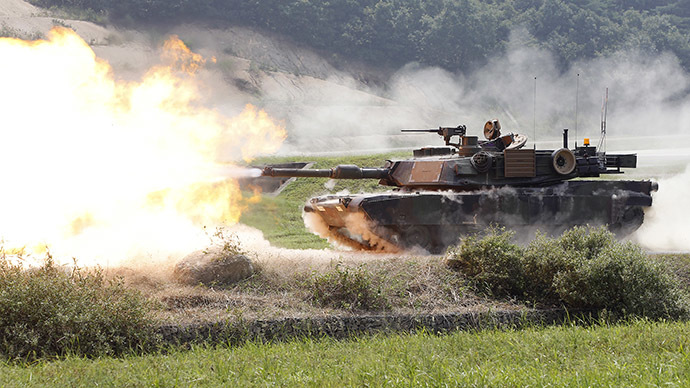Pentagon’s new military strategy calls for preserving US dominion of the world

The US military needs to remain engaged around the world against both rival states and non-state actors, while nurturing regional allies and promoting American values, declares the Pentagon’s new National Military Strategy 2015.
That the United States is “the world’s strongest nation, enjoying unique advantages in technology, energy, alliances and partnerships, and demographics,” is the underlying assumption in thedocument. “However, these advantages are being challenged.”
The main challengers are the state actors of Russia, Iran and North Korea, and non-state groups – particularly the “violent extremist organizations” (VEO) such as Islamic State and the Taliban. The strategy attempts to create a unified approach to dealing with both, seeking to “deter, deny, and defeat” the states and “disrupt and degrade” the non-state groups.
The document blames Russia for violating “numerous agreements” with its “military actions.” This list of agreements includes a number of pacts that US has been also violating such as the Intermediate-Range Nuclear Forces Treaty.
Iran and North Korea, on the other hand, are accused of seeking nuclear weapons. The document explains that the US would like to see China, which is not listed as a rival, as part of the international order, rather than a regional power challenging Washington’s dominance.
Pentagon issues 2015 National Military Strategy. Nifty Venn diagram highlights challenges… http://t.co/zQbdvuTH8Fpic.twitter.com/r0jGcWJsEr
— Mark Thompson (@MarkThompson_DC) July 1, 2015
“None of these nations are believed to be seeking direct military conflict with the United States or our allies,” the document summarizes. “Nonetheless, they each pose serious security concerns which the international community is working to collectively address by way of common policies, shared messages, and coordinated action.”
READ MORE: More airstrikes & advisers: US claims to have a ‘clear strategy’ against ISIS
The Pentagon aims to address the conflicts against “VEOs” by addressing the “root causes” of conflicts in failed states, with the military helping providing security while governments and international agencies provide economic opportunities and humanitarian assistance.
Kremlin spokesman Dmitry Peskov has expressed regret over the new US National Security Strategy - presented in Washington on Wednesday - not aiming to normalize relations with Russia.
The hostility towards Russia expressed in the document “testifies to a confrontational attitude devoid of any objectivism with respect to our country," Peskov said, as cited by TASS.
Such attitude is unlikely to contribute to the efforts to "steer our bilateral relations towards normalization,” pointing out that the present-day challenges, such as opposing the dangerous Islamic State and terrorism as such, could only be coped with joint response, Peskov stressed.
Technological frontier
"We now face multiple, simultaneous security challenges from traditional state actors and transregional networks of sub-state groups — all taking advantage of rapid technological change," Chairman of the Joint Chiefs of Staff Gen. Martin Dempsey wrote in the introduction. "We are more likely to face prolonged campaigns than conflicts that are resolved quickly."
Driven by globalization, technology is enabling other states and groups around the world to challenge the advantages long enjoyed by the US, such as early warning and precision strike capability, the document notes. This requires the US to embrace “greater agility, innovation, and integration” to meet these challenges, and “reinforces the need for the US military to remain globally engaged to shape the security environment and to preserve our network of alliances.”
Brian Becker, director of the ‘Answer’ anti-war coalition, says that complaints about losing technological advantages are largely targeted at the domestic public. “American are being told that there is no money for hospitals, schools and many other vitally needed social programs, but suddenly we will have a clarion call that the United States must catchup, it must not let its adversaries Russia or China become superior to America, this is precisely what triggered the arms race in the 1950s,” he said to RT.
Global presence
US military presence around the world is explained as key to the security of allies and partners, a factor of stability in promoting “economic growth and regional integration” and giving Washington the capability to react swiftly in case of a crisis.
“We are prepared to project power across all domains to stop aggression and win our Nation’s wars by decisively defeating adversaries,” the document states. “While we prefer to act in concert with others, we will act unilaterally if the situation demands.”
The strategy says that the US “will press forward with the rebalance to the Asia-Pacific region, placing our most advanced capabilities and greater capacity in that vital theater.” It also remains committed to NATO allies and Israel’s security.
“If you look at what the US is doing, not to what it says in the document, the pivot towards Asia is a pivot of containment,” Becker says. “The new military strategy, which is to take all of the non-Chinese republics and nations in the region and forge them into a US-led military alliance, cannot be perceived in China as anything else but a threat to its national interest.”
In addition to safeguarding the survival of the US and prevention of a “catastrophic attack,” the national security interests articulated in the strategy include the “security of the global economic system,” the “security, confidence, and reliability of our allies,” and the “preservation and extension of universal values.”
The last several months have seen changes at the helm of the US military, with Ash Carter replacing Chuck Hagel as Defense Secretary in December 2014, and General Dempsey announcing in May that the would retire later this year. President Barack Obama nominated Marine Corps Gen. Joseph Dunford to replace him.












